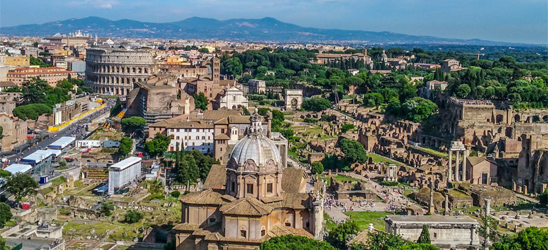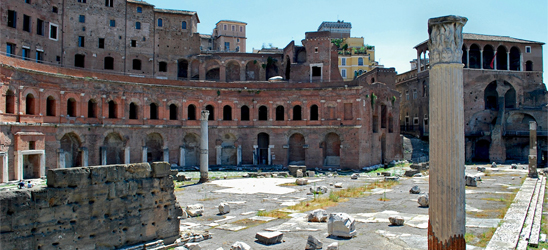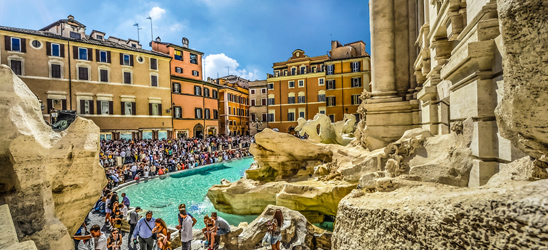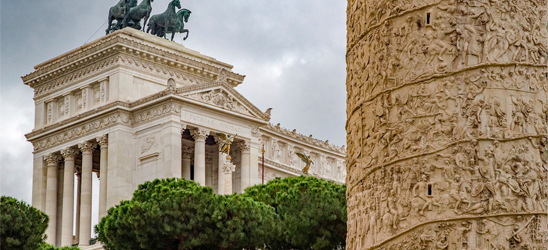The Campidoglio Museums' beauty will be at first anticipated from the wonderful square which embraces the monumental complex.
Piazza del Campidoglio, in its current appearance, was designed by the great Michelangelo in the mid-1500s.
The Capitoline Museums boast the primacy of being considered as the "first museum in the world". It is intended as a place where art could be enjoyed by everyone and not only by the owners.
First, in 1471 Pope Sisto IV donated to the Roman a group of bronze statues. The collections were increased by successive pontiffs with works coming from the excavations of Rome, from the Vatican or purchased directly for the museum. The entire collection is located in two distinct places, connected to each other by an underground gallery that houses the Galleria Lapidaria: il Palazzo dei Conservatori e il Palazzo Nuovo.
Capitoline Museums in Rome: PALAZZO DEI CONSERVATORI
The renovation of the square was entrusted to Michelangelo. He also designed the facade of the Palace, but he never succeeded in finishing it.
Our journey inside the ancient begins entering the courtyard. First of all, on the right side we find the fragments of the statue of Constantine found in 1486. The estimated height of the statue had to reach 12 meters. Imagine that only the head measures 2.60 meters!
On the opposite side are the reliefs depicting the Provinces, coming from the temple dedicated to the emperor Adriano, deified after his death. After passing the colossal statues of the Dacians made of golden marble, we can continue our visit to the upper floor.
Among the reliefs on show, the most famous are the mosaics with tiger and calf, which have become the emblem of the Campidoglio and its museums.
The main floor is characterized by the beauty of the frescoes decorating the ceilings and walls. Among the most important works, there is the Statue of Pope Urban VIII Barberini. It was created by Gian Lorenzo Bernini between 1635 and 1640. This artwork is displayed in the Sala degli Orazi and the Curiazi.
Continuing our visit we arrive in the most important hall of the entire building: the Sala della Lupa. This space in antiquity was a loggia that opened towards the city. At the center of this room is the statue of the animal symbol of the city: the famous bronze Capitoline Wolf, donated by Pope Sisto IV.
An exceptional room was dedicated to a particular work: in 2005, the Esedra of Marco Aurelio emperor was inaugurated. The effect created by this new exhibition leaves you breathless, the light reaches the equestrian statue of the emperor and accentuates the authenticity and the golden bronze color. This huge statue is so important because it is considered the only equestrian statue of the classical era that has been integrated into the contemporary era.
Through the Galleria Lapidaria we go to visit the other part of this museum complex. This underground passage probably in antiquity had the role of an ancient state archive, of which we have no definite information.
Capitoline Museums in Rome : PALAZZO NUOVO
Also the design of this palace was created by Michelangelo with the portico on the ground floor and the orientation slightly oblique, so as to give a more precise symmetry to the Piazza del Campidoglio.
This building contains countless works located in these wonderful rooms. In the courtyard there are three colossal statues: Morforio, Pan and Marte.
During the pontificate of Cement XI numerous works that decorated the Egyptian pavilion, were acquired. Among the most representative works you can admire a large bell-shaped crater from the Villa Adriana and a series of animals depicting the emblem of the most important Egyptian deities: the crocodile, a sphinx, a scarab.
The structure of the second building is specular to the first. You enter the upper floor through a staircase that leads us into a series of rooms full of marble and much more.
One of the halls that stands out for its uniqueness, is definitely the Cabinet of Venus.
This small polygonal room, similar to a nymphaeum, frames the statue Venus Capitolina, found during the pontificate of Clemente X at the Basilica of San Vitale.
This statue, 1 meter and 93 centimeters high, is made of fine marble and represents a young woman just out of the bathroom intent on covering her nudity.
The environment enhances this wonderful masterpiece, accentuating the grace of this young woman.
We stroll past numerous emperors and philosopher and after going through the hall we meet a very unique statue: the Red faun.
This statue, which gets its name from the color of its ruby red marble, represents the young mythological figure while dancing.
We end our visit with the last important room: the Galata hall.
The most well-known work of the entire collection is the central statue representing Galata Capitolino, a character that was mistakenly interpreted as a gladiator in the act of falling on his shield.
Other wonderful statues fill the room: the Wounded Amazon, Cupid and Psyche and the Resting Satyr.



 EN
EN  ES
ES  DE
DE  FR
FR  IT
IT 






